As the old saying goes, “clothes make the man”–but is this always true? While dressing up undoubtedly has numerous benefits, a gentleman who is well versed in proper sartorial practices will also be familiar with a few unique pitfalls and problems. We’ve compiled them here so you’ll be better equipped to overcome them and look your best.
- 1. Collar Gap
- 2. Shoulder Divots on Jackets
- 3. Flyaway Collars
- 4. Second Shirt Button in the Wrong Place
- 5. Pocket Square Sinking or Rising
- 6. Difficulties with Sleeve Length
- 7. Getting the Right Tie Length
- 8. Pleats that Stay Open
- 9. Not Being Able to Use Your Pockets
- 10. Keeping Light Pants Clean
- Socks for light colored pants
- 11. Keeping Pants at the Right Length
- 12. Managing Your Socks
- 13. Creases on Your Shoe Vamp
- 14. Asymmetrical Shoelaces
- Conclusion – We all have problems
- Outfit Rundown
Those who frequent social media have no doubt encountered the concept of #FirstWorldProblems, a hashtag used to describe minor irritations that frustrate people who live otherwise comfortable lives. An example might be having your name misspelled on your Starbucks order or finding Hulu is down when you want to binge-watch a classic TV show.
In the same vein, we’ve compiled a list of #GentlemansProblems from top to bottom of a tailored outfit: things that devotees of classic menswear will suffer from that others probably wouldn’t even notice.
1. Collar Gap
Let’s start at the very top of your jacket. Collar gapping describes the way the back collar of your suit jacket or sport coat can pull up and away from your shirt, usually on one side of your neck. The particularly frustrating aspect of it is that the cause is not easily found.
It can be experienced with jackets that are quite roomy, and jackets that are very fitted. It has been reported to happen if the collar of a jacket is too large for your neck, but the fact that it mostly shows up on only one side of the neck suggests a different cause, perhaps having one shoulder that is lower or wider than the other.
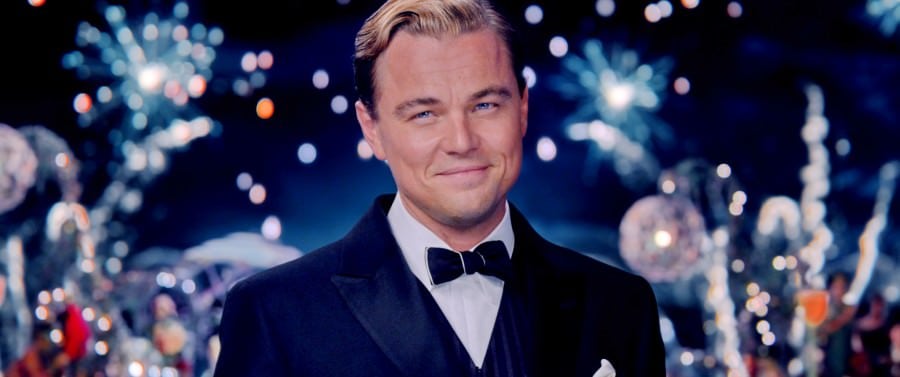
Some men find it happens on every single ready-to-wear jacket they try on, which makes it especially frustrating; in this case, made-to-measure or full bespoke may be the only solutions to address the issue.
It may also be possible to cheat the collar gap by having a tailor lower the top button slightly if the gap is on the right side of your neck; this will pull that side of the jacket down a bit more when you close it, pressing the collar closer to your shirt.
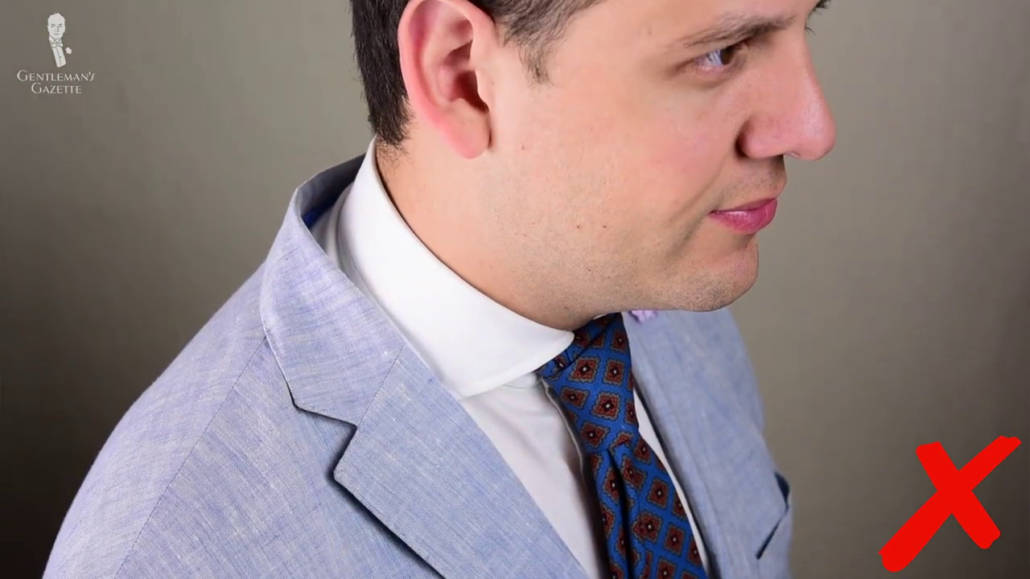
Others have found certain brands in which there is no gapping and stick with these. For example, one of our contributors, Dr. Christopher Lee, has found that fuller-cut jackets like those made by The Armoury or Ring Jacket seem to avoid gaps while Suitsupply, which is more fitted, does not.
A collar that occasionally shows a small gap when you sit or move your arms a certain way may not be noticed by those around you, but once you’re aware of it, it will likely become a deal-breaker for you, and you’ll see it everywhere on others: politicians, the weatherman, actors on TV, and athletes doing NFL commentary. For this reason, it’s definitely a #GentlemansProblem.
2. Shoulder Divots on Jackets
This one is even less noticeable to the general public, but is similar to the collar gap in being difficult to diagnose. It occurs when you have your arms at your sides (in the “natural resting position”) and can see dimples (or “divots”) just above the biceps on your suit jacket sleeves.
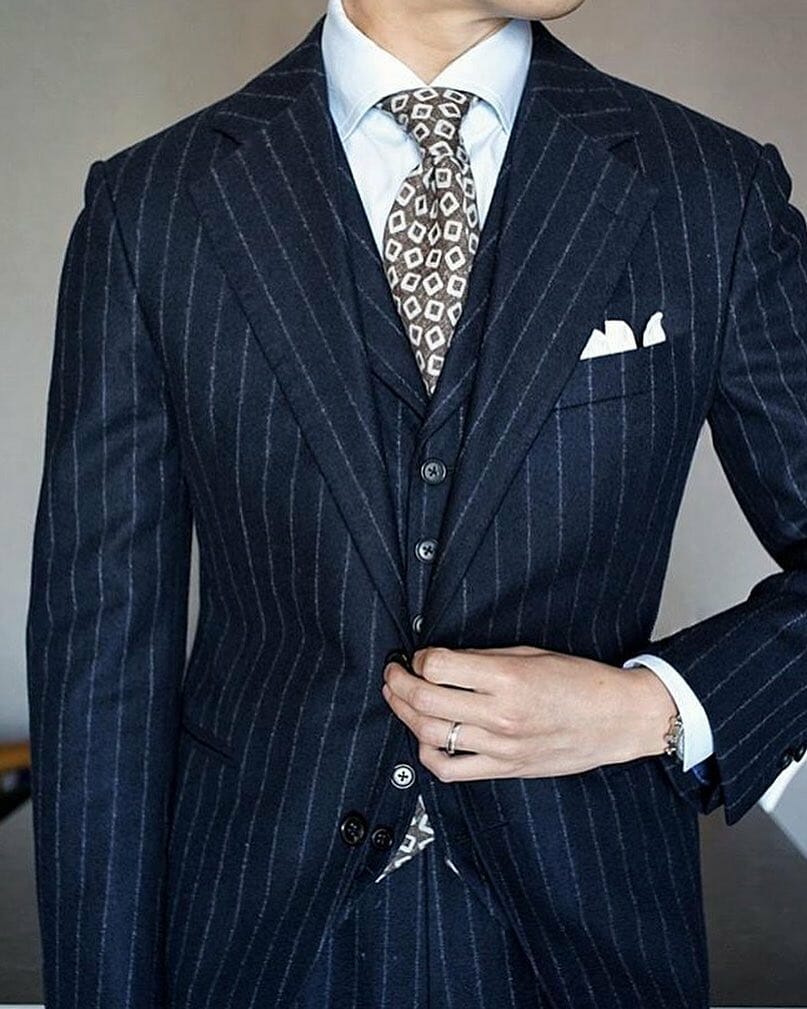
These indentations can appear on both sleeves or just one, and seem to be more common or noticeable on flannel rather than lighter summer fabrics.
Contrary to popular opinion, this issue is not always caused by jacket shoulders that are too wide, but rather by several possible factors. One is a sleeve pitch or rotation that does not jive with the way your shoulders sit, and the other is an armhole that is too small for the sleeve.
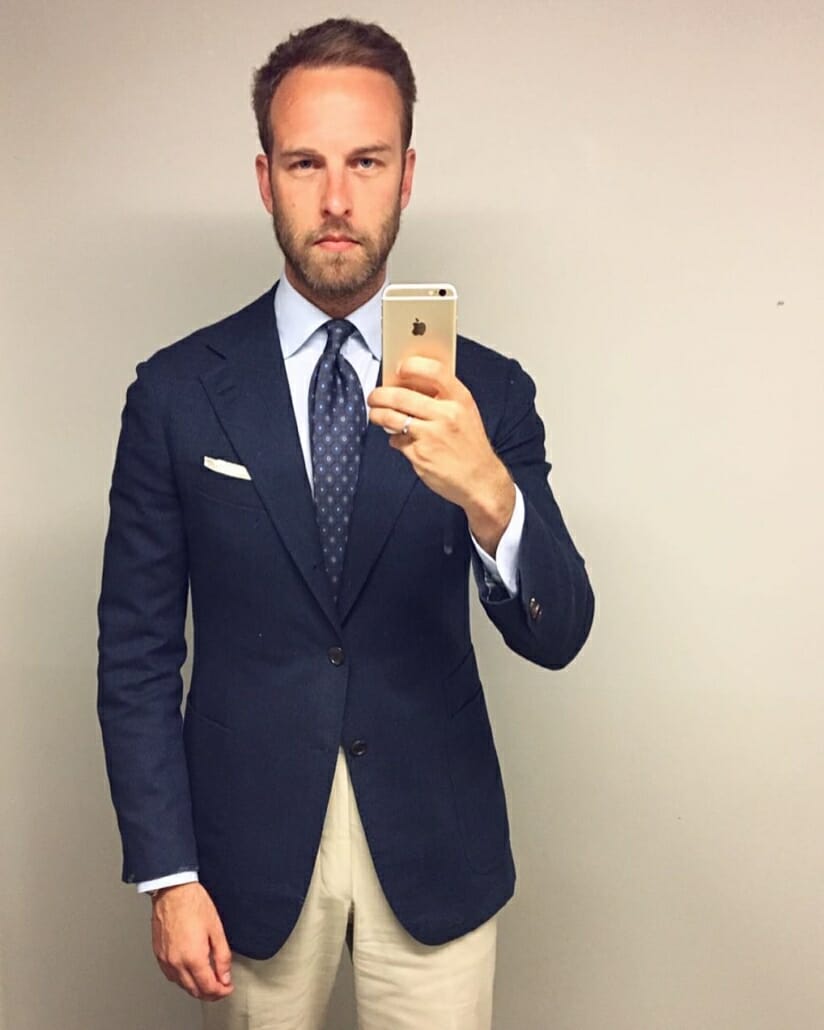
Tailors can make attempts to fix these issues with varying degrees of success, though if you see it on a jacket you are looking to buy, you may want to think twice rather than hoping that alterations will fix the issue. Most casual observers (such as your friends, family, or co-workers) will not notice the problem, but once you are aware of it and see it on a jacket, it’ll drive you crazy.
3. Flyaway Collars
Flyaway collars can be unique or problematic depending on your personal taste. This is something that happens when the collar points of your shirt don’t sit where they should, which is flat against the rest of the shirt and firmly under the collar of a suit jacket or sport coat if you’re wearing one.
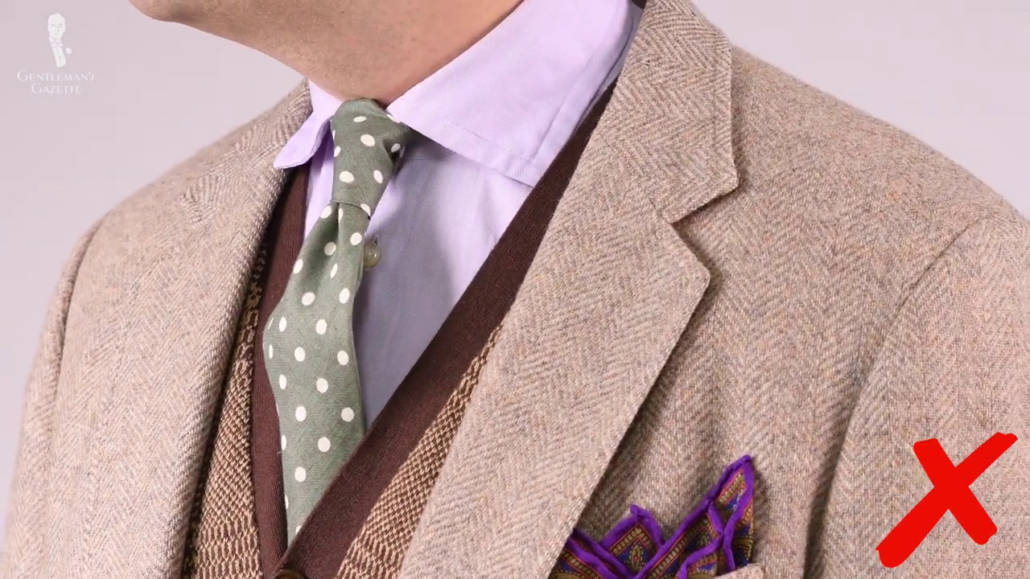
The flyaway collar, in various forms, happens if the collar points (or just one point) stand away from the shirt when it is fully buttoned and worn with a tie. This will occur if the collar is small and stiff or if it is long and soft, so either extreme of length and stiffness will cause it.
Collar stays will do much to solve this problem, but making sure that your collar complements the build of your neck and shoulders is the ultimate key.
4. Second Shirt Button in the Wrong Place
The second shirt button is the one you keep buttoned if you open your collar and wear your shirt without a tie. If this button is placed too high on the shirt, you’ll still look “buttoned-up” and boring with your collar button open. On the other hand, if it’s too low, you’ll look like Tony Manero in Saturday Night Fever, maybe even with some chest hair showing.
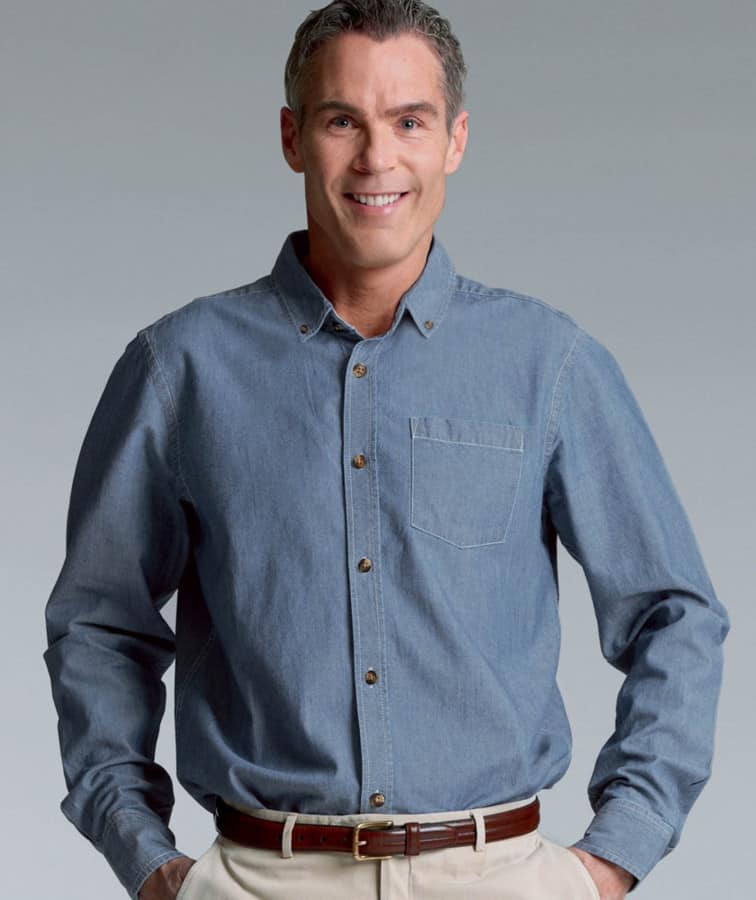
One solution is finding a brand that places its second button at the right height. The other option is going custom, in which case you can arrange to put the button wherever you need it to appear relaxed and slightly rakish–neither too conservative nor too playboy. This is something the stylish gent will worry about while the average person will most likely just go with any button location.
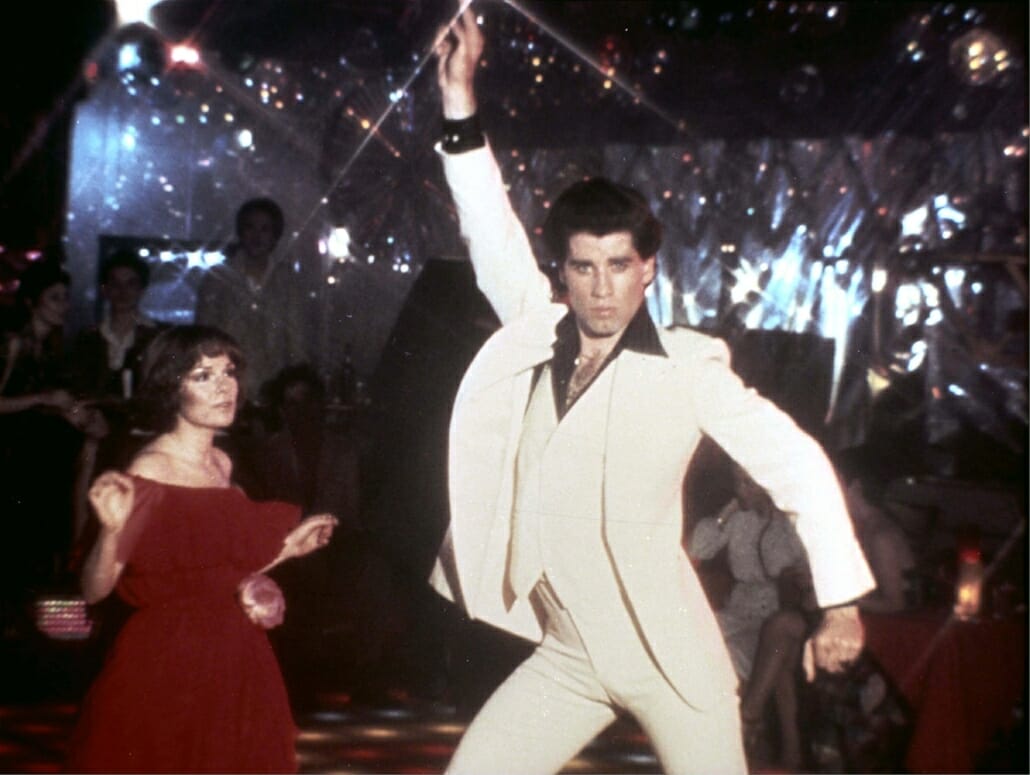
5. Pocket Square Sinking or Rising
Many men don’t even wear pocket squares, so the idea that one can sit too low in your jacket pocket or billow out too much is purely a gentleman’s problem.
Depending on the size and material your pocket square is made of, it can either sink down too much, so it can’t be seen at all (usually if it’s small–under 12″ square–or heavy), or it balloons up like a souffle and looks silly. The latter happens mainly with satiny silks, which are a combination of airy and slippery.
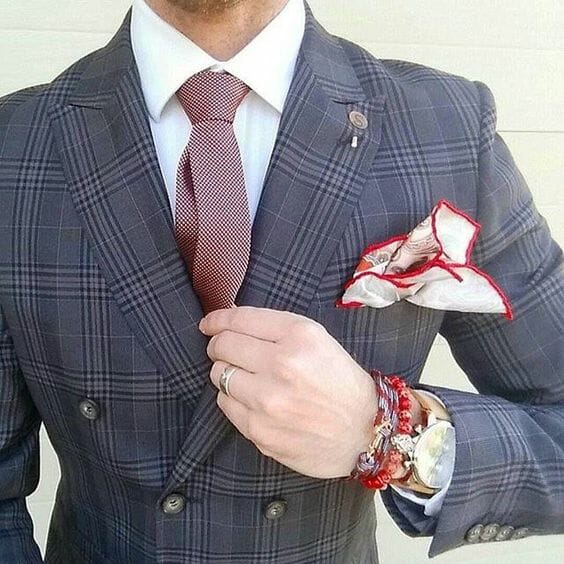
Frankly, with some pocket squares, there is no solution except to jam it back down or pull it back up at various times during the day. Some specific folds and pocket squares of the ideal size for your pocket may help, but it depends on the size of the individual pocket and square, so experiment for yourself.
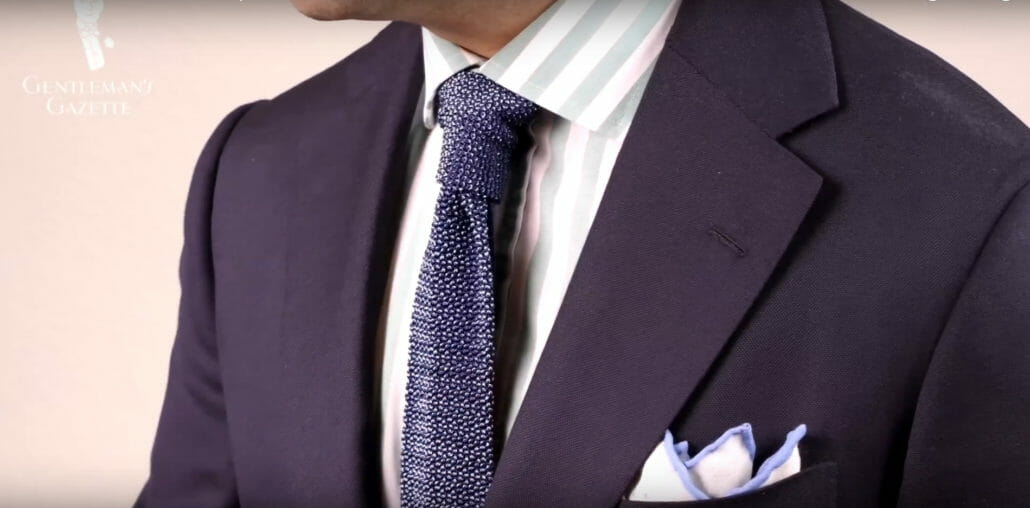
You can try something like a pocket square holder, but usually, such gadgets are a waste of time and money.
6. Difficulties with Sleeve Length
How much shirt cuff should show below the sleeve of your suit jacket is a topic that takes up a lot of space in online menswear forums. The conventional response on proper sleeve length is 0.25-0.5 inches.
This is fine and dandy until you have a bunch of different jackets with different sleeve lengths along with a variety of different shirts. Some jackets (usually Italian cuts) have shorter sleeves than others.
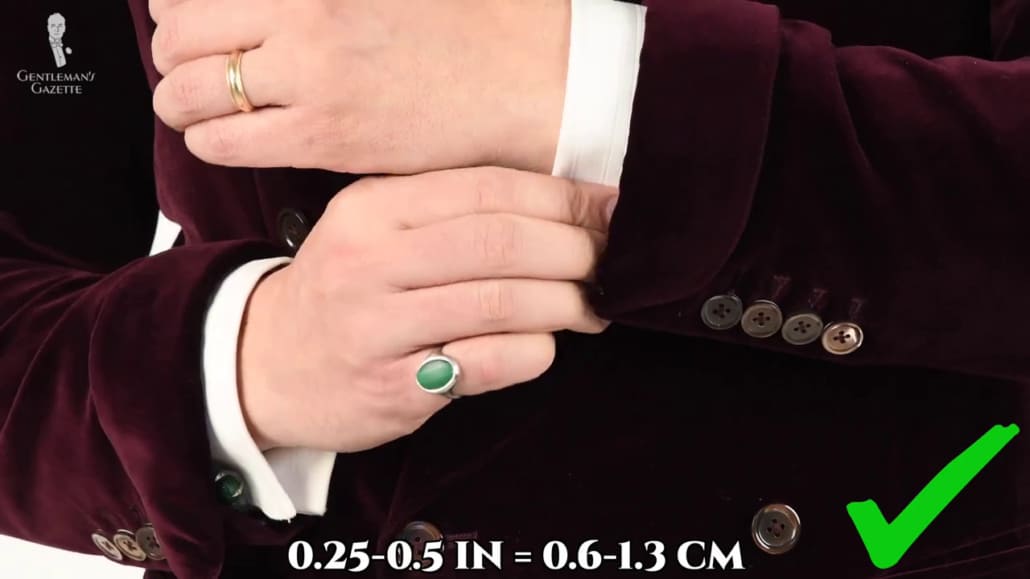
Shirt sleeve length varies off the rack, as well, and if it’s too short to peek out that 1/4-1/2″ below your jacket sleeve, you can’t go to a tailor and tell him to make them longer. So, even if you alter jacket sleeves as much as you can to get a decent length, you find some shirts have cuffs that sit at the perfect length for your jackets while others still do not.
This means keeping track of which shirts work with which jackets or buying specific shirts at different sleeve lengths. The optimal solution is really to get custom shirts made up with a proper sleeve length to suit your arms, but you may still need some shorter ones for Italian summer jackets if you don’t want to show too much cuff.
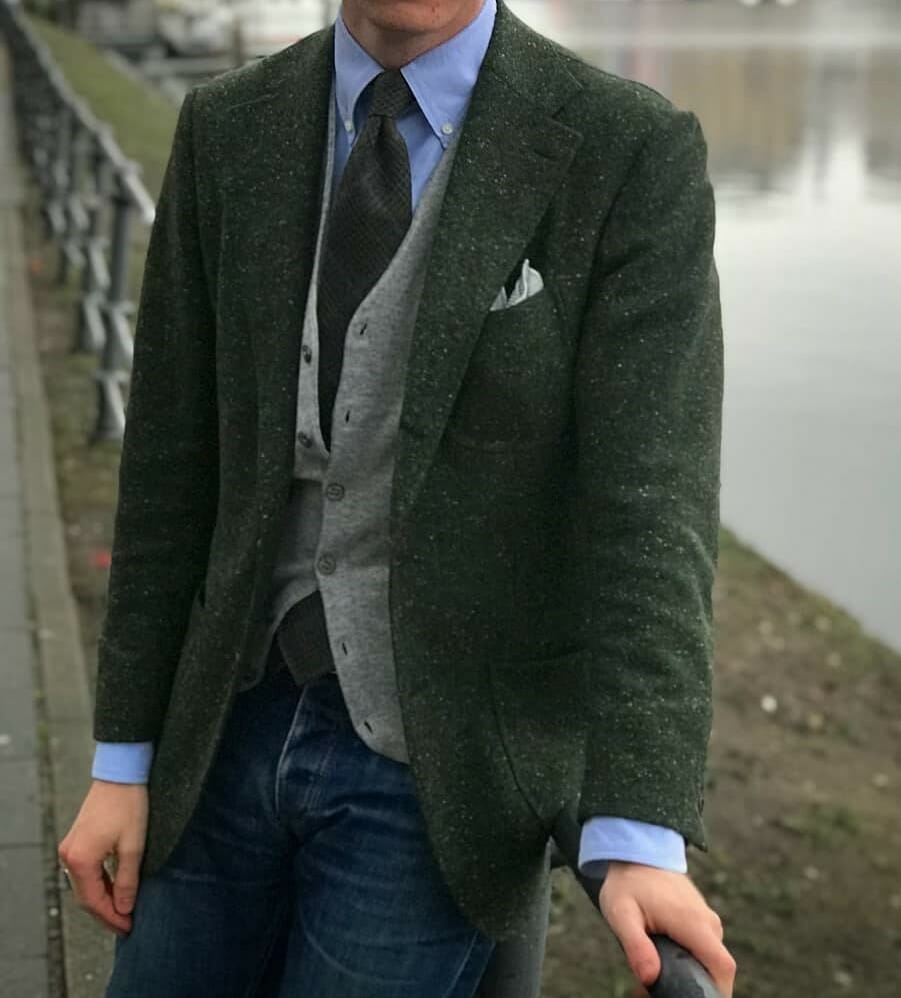
Many guys will also have one arm slightly longer than the other, or one shoulder lower than the other. This will mean the amount of cuff showing on your shirts will always be uneven unless you go totally custom-made or get a longer-sleeved shirt and alter one side differently than the other.
All in all, exposing the correct length of cuff is a #GentlemansProblem that’s complicated enough to make you tear your hair out.
7. Getting the Right Tie Length
The question of how long your necktie should be–just touching your waistband is the general rule–occupies the man who is new to dressing well. However, even when you are a pro at it, tie length will continue to be a #GentlemansProblem. For one thing, depending on your height, you may find ties either too long or too short.
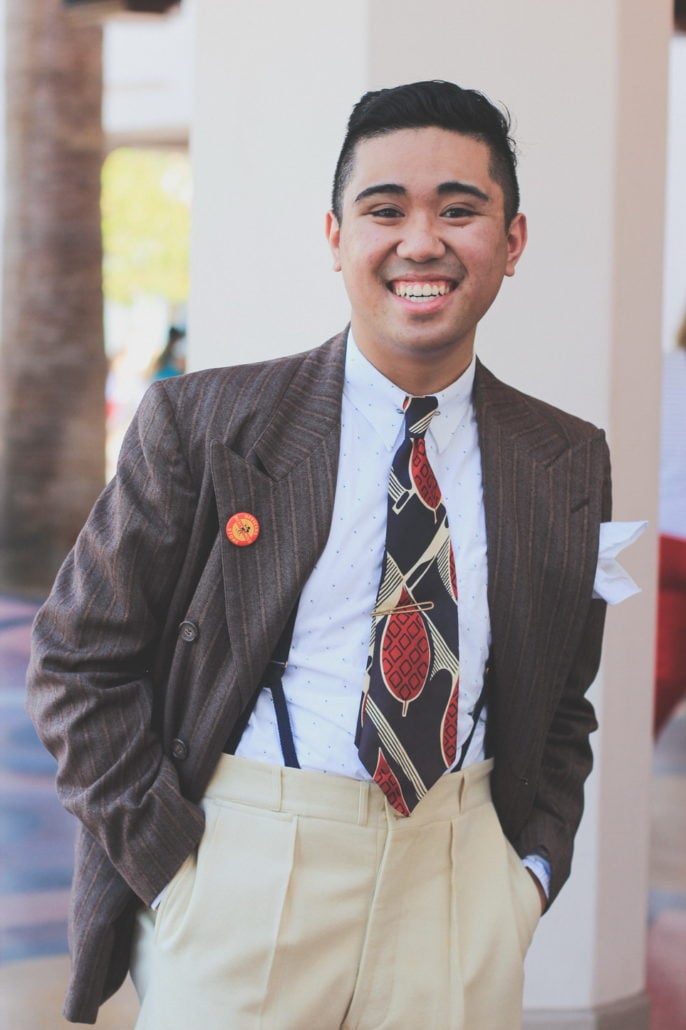
If you adjust the length of the front blade to satisfy the rule, you might find your back blade either too long if you are on the short side, or too short if you are tall. Moreover, if you have pants with a high rise, your standard ties will be too long.
One solution is to do a double four-in-hand knot (which is to say, looping around twice rather than once) to effectively shorten the blades. Another is to tuck one or both blades into your waistband, a look some men are not too fond of, though it does remain invisible if you keep your jacket closed.
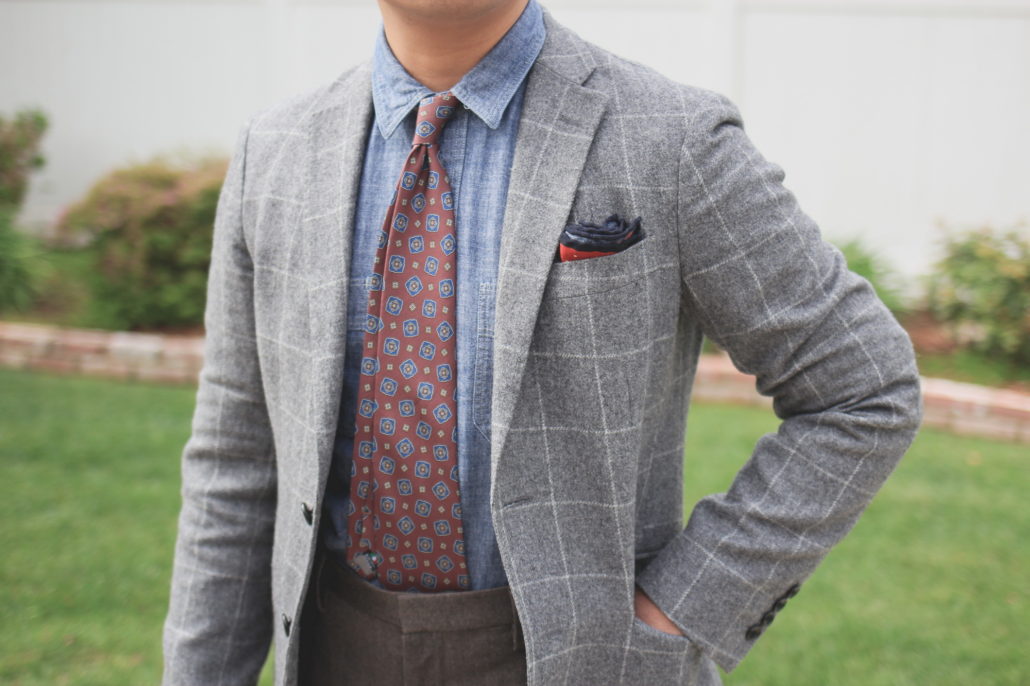
Both of these issues affect even the world’s most well-dressed men, such as Andreas Weinås, who has complained about how his ties often end up with back blades that are too short. Two factors compound the difficulty. One, off-the-rack ties can vary in length from 57″ to 60″ in a standard range, and those three inches can make a world of difference in where the tie ends on your body.
The second factor is that bespoke ties are not easily found and can be costly. When they are available, they can come in only more business-like printed silks rather than woven or textured ties. Fortunately, Fort Belvedere offers many of its ties in a range of lengths from short to long to help alleviate the issue.
8. Pleats that Stay Open
It’s likely safe to say that a great many men these days will scorn pleated pants outright, but we’re willing to bet that once you try them in a cut that fits well, you’ll be sold on them as a variant in your wardrobe.
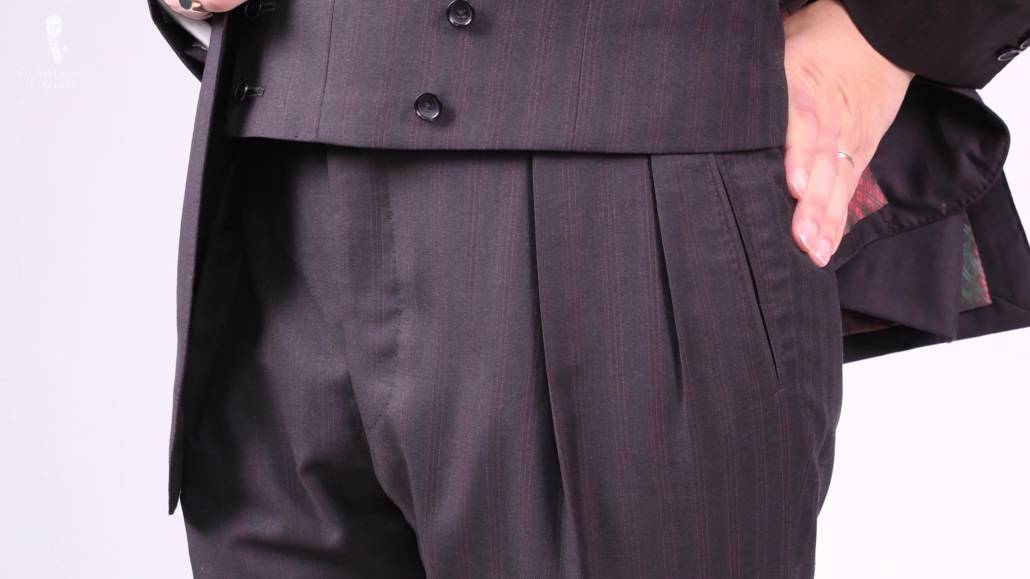
The problem encountered by wearers of pleated trousers, though, is when the pleats on the front pull open and stay open while you’re standing. This seems to happen if the pleats are small or sewn too tightly, or if your pants are too tight.
The result is that the front of the pants (the rise) doesn’t look as clean as it might. In extreme cases, it can lead to your pants showing some “ballooning.” If you have a jacket on, no one will likely notice it, but once you see it, it will be a source of dissatisfaction.
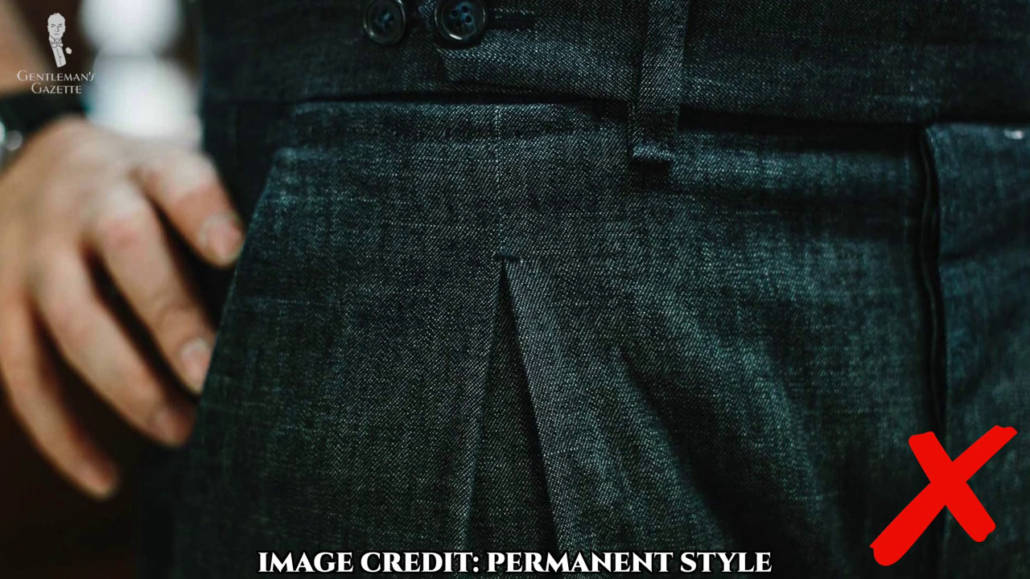
The solution is to try the pants on to make sure the pleats stay closed based on a good fit (though they could also be sewn down). Further, inward-facing pleats will gap less than those that face outward.
9. Not Being Able to Use Your Pockets
Back in the day, your author used to carry a large billfold wallet in his front pants pocket. In the other pocket were keys and even a hairbrush. This, of course, should give pause to any gentleman of style. Anything that creates a visible lump in your pockets not only looks vulgar (“Is that a wallet or are you just happy to see me?”) but ruins the clean appearance of the fabric.
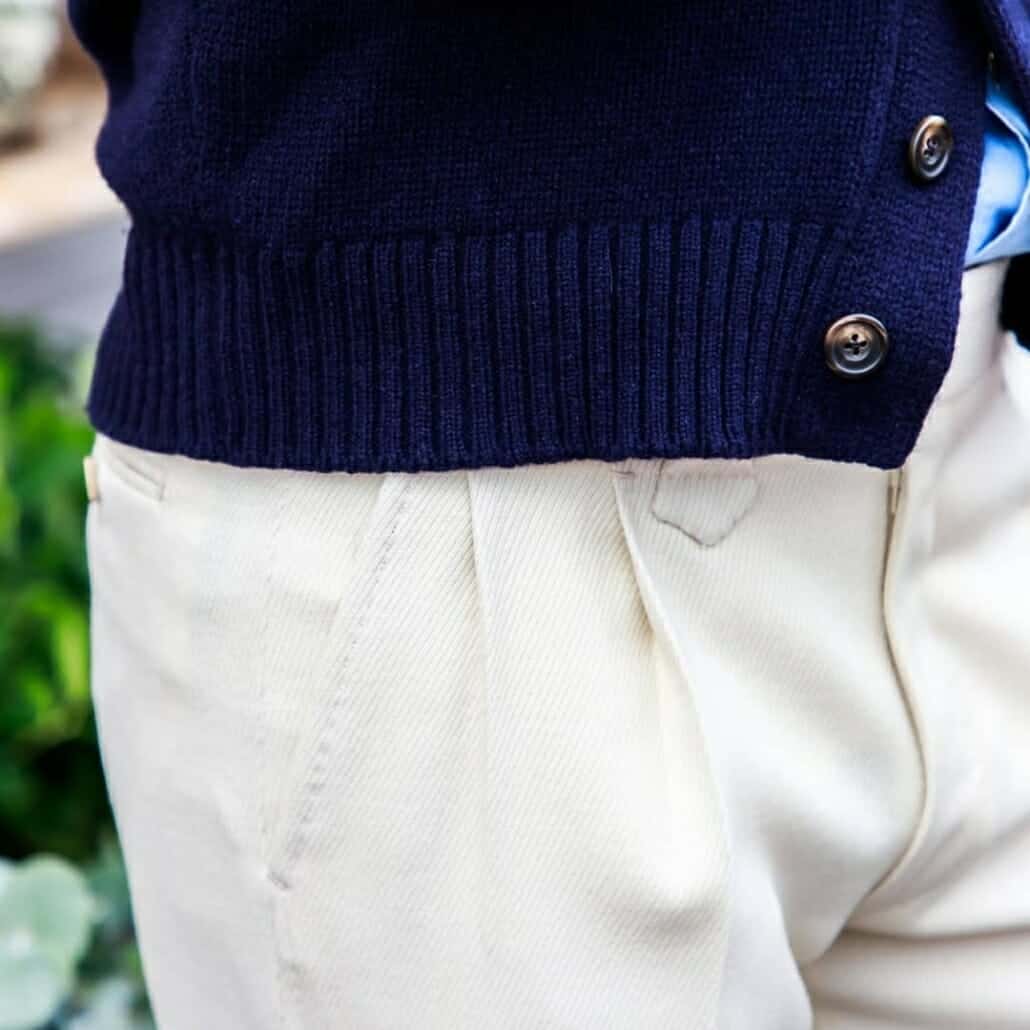
It might be wise to just carry a few bills and a loose key or two in your trouser pockets, with a small bifold cardholder in the left inside pocket of a sport coat, where it isn’t visible. Some gents swear by a larger wallet worn in the same inside pocket, but this isn’t just uncomfortable; it also ruins the look of your pocket square if you wear one.
Of course, besides your pants, you can’t really use the outside pockets on a suit jacket or sport coat either, especially if they’re patch pockets, because that will eventually lead to unsightly stretching and sagging of the pocket, which cannot be fixed.
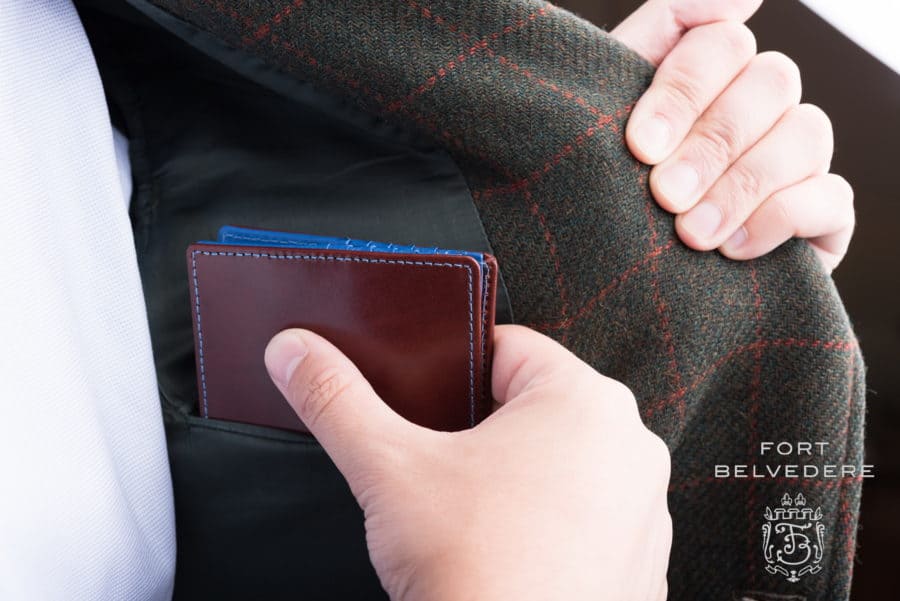
So, the solution is to keep your “everyday carry” light and use the inside pockets as much as possible. Ironically, though classic menswear tends to have a surplus of pockets, the gent concerned with appearance will often sacrifice utility for style.
10. Keeping Light Pants Clean
Frankly, men with little interest in style don’t often wear light-colored pants. Some men may be reluctant to do it, in fact, because they think that telegraphing their attention to clothes is somehow unmasculine.
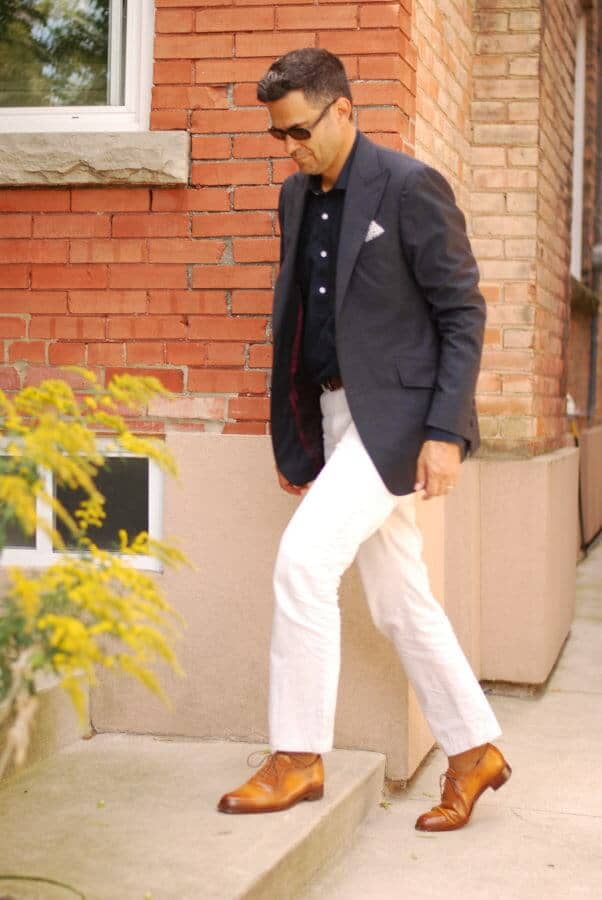
While this is a false assumption, those who make the foray into off-white and white trousers do have to wrestle with the problem of keeping them clean, which is more of an issue with pants than shirts or jackets because they’re close to the ground and you sit on them.
Stylish gents wearing light colors will find themselves sweating over sitting on public benches or on the subway—maybe even putting down a magazine or handkerchief to sit on–and they’ll get anxious when eating pasta with sauce or curries.
For sure, it requires a great deal of care and attention, which can either be a tremendous pain or a way of slowing down and concentrating on something in an otherwise hectic world. Fortunately, effective stain removal methods do exist, for whenever accidents happen.
11. Keeping Pants at the Right Length
Continuing with clothes worn below the waist, we have the issue of controlling pants length. Whether one wants a break or no break, cuffs or no cuffs, is open to one’s taste, with the prevailing wisdom being that trouser hems should either just touch one’s shoes or show a minimal break. However, both of these choices make one prone to a particular #GentlemansProblem.
During the day, your trousers can subside to below the ideal position, even with a belt or side adjusters, creating a larger and more sloppy break over your shoes. This is hard to avoid because when you set your hem length at the tailor, your pants are hiked up to where you want them, not where they will sink later.
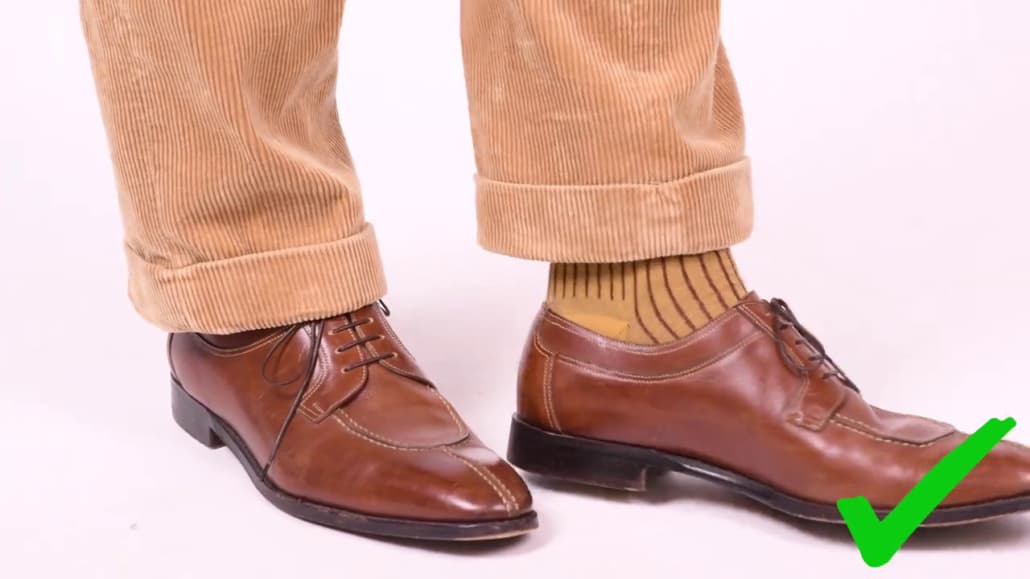
Many gents who want to keep their trousers looking sharp will simply pull up their pants a few times during the day, but the best solution is wearing suspenders. Because they hold your pants at the right length from your shoulders, they should prevent sinking and maintain a clean leg line. For the true connoisseur of classic style, suspenders are a must.
12. Managing Your Socks
The usual advice on dress socks for men is that they should always be over the calf (OTC). The shorter variety popular today that come halfway up your calf will sag or bag, and when you sit, they’ll expose your hairy shins, which is a faux pas.
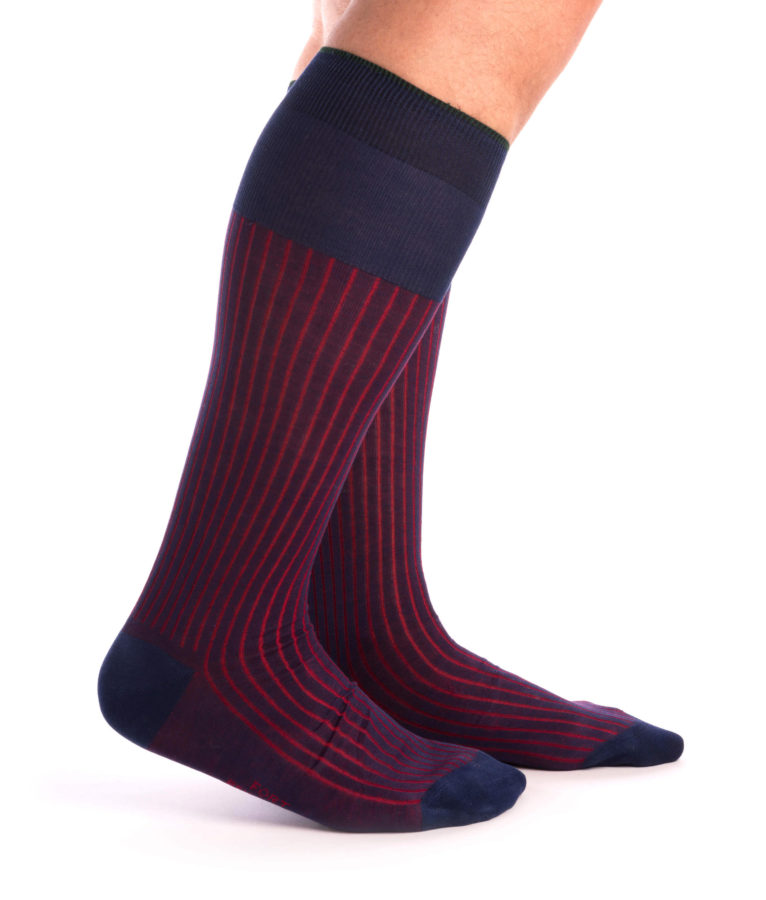
However, wearing OTC socks is easier said than done. In warm weather, they may feel too hot, while if you wear them with flannel pants in the winter they’ll ruin the line of your pants (the inside of your pants legs will cling to them and cause bunching).
Sometimes it seems necessary to wear shorter socks, which then create the issue of socks that droop during the day. This is an age-old problem once solved by wearing sock garters, which are considered silly-looking today, not to mention being a royal pain.
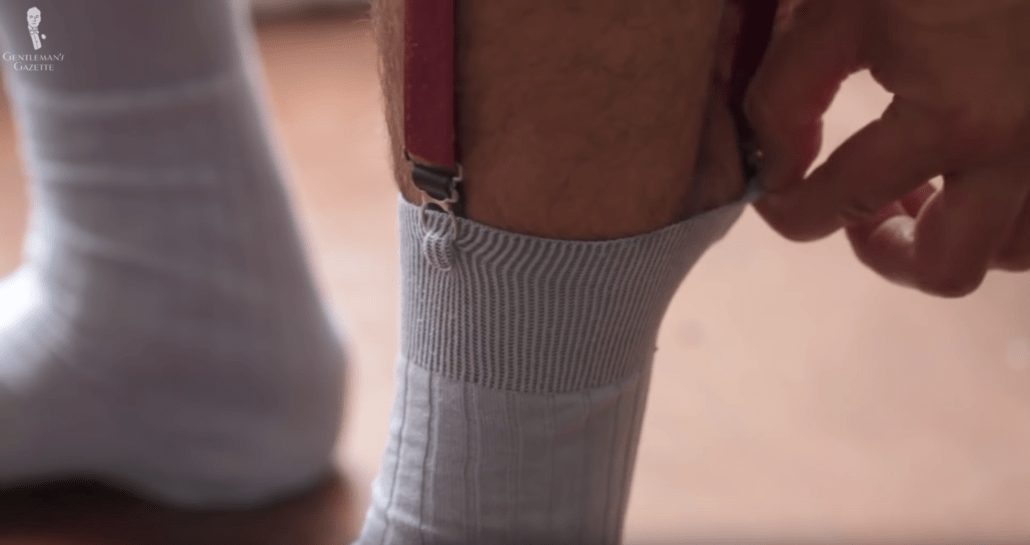
Some nylon content in your socks helps alleviate the problem somewhat but not entirely, so you may be left with pulling up your socks at various times while being careful not to show your bare legs when you sit down. An alternative solution may be shirt stays, if you can warm to the idea of wearing them.
13. Creases on Your Shoe Vamp
Like most articles of clothing, dress shoes look their best when they are new and unworn. Once you put them to use, they’ll inevitably develop scuffs, dings, scratches, and gouges, all of which can be camouflaged by polishing except in one place: the vamp, or the top of the shoe directly behind the toe.
This is where your foot (and therefore the leather of the shoe) bends when you walk, creating permanent creases in the material. Nothing seems to agitate the shoe-obsessed more.
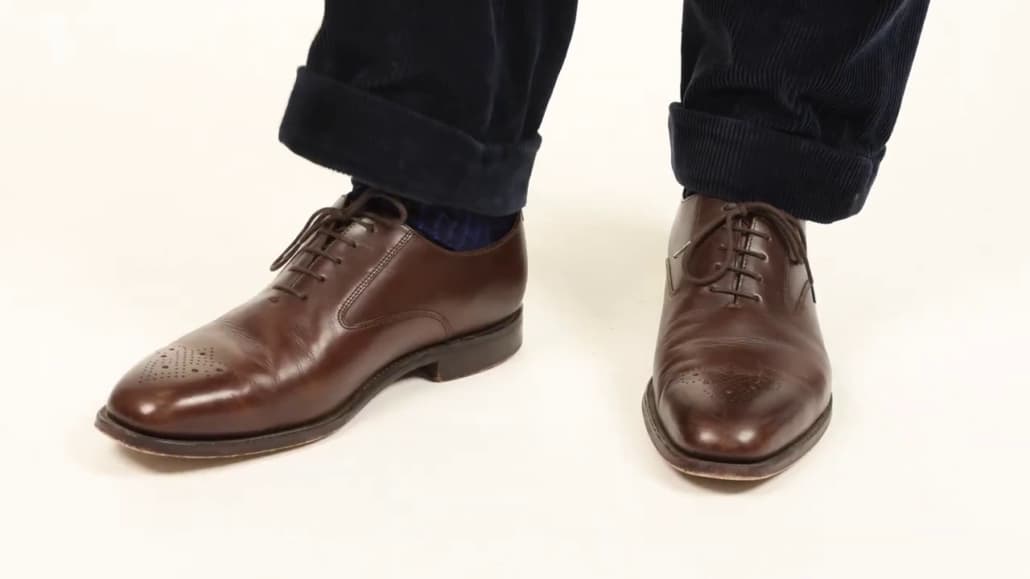
Complaints abound online concerning creased vamps, and people desperately seek advice on how to prevent it from happening. Once creases occur, they can’t really be removed, and polishing this area is impossible because the wax will cloud and crack as the leather continues to flex. So, what do you do? First, buy good quality shoes. Thinner, cheaper leather will crease more and look worse.
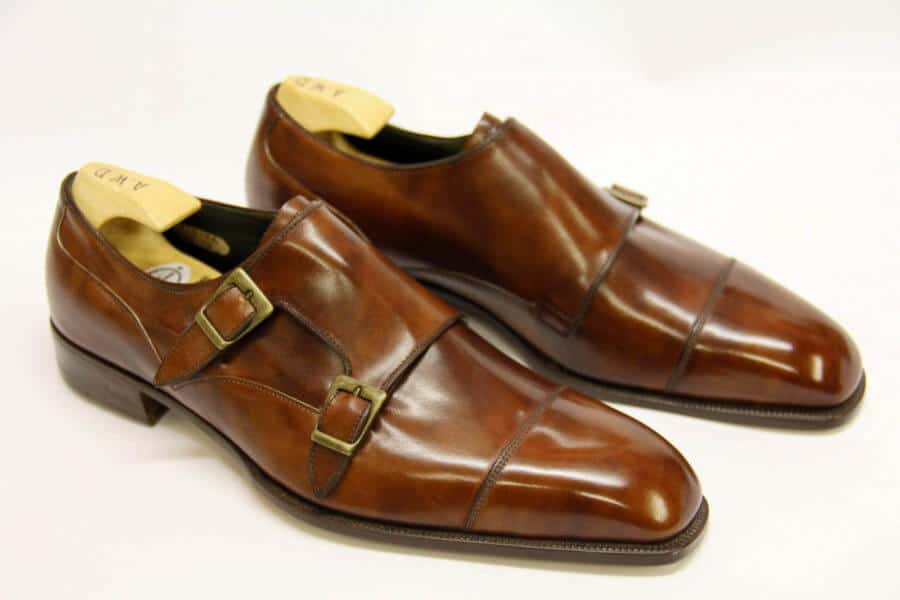
Next, use shoe trees when you store your shoes after wearing them. These will help minimize creasing by holding your shoes in their original unflexed position. Lastly, live with the creases. Of your entire wardrobe, shoes may be the most hard-working and subject to use. Some creasing is natural and only adds to the lived-in beauty of a quality pair of shoes.
14. Asymmetrical Shoelaces
This may be the most overlooked and finicky of #GentlemensProblems, but once you know about it, you may never be able to unsee it. When you tie your shoelaces, you probably loop the left lace over the right when you make a bow.
The end result is that the finished bow will be twisted slightly on a diagonal. It won’t lie straight across or perpendicular to the shoe. No one will notice or care—except you!
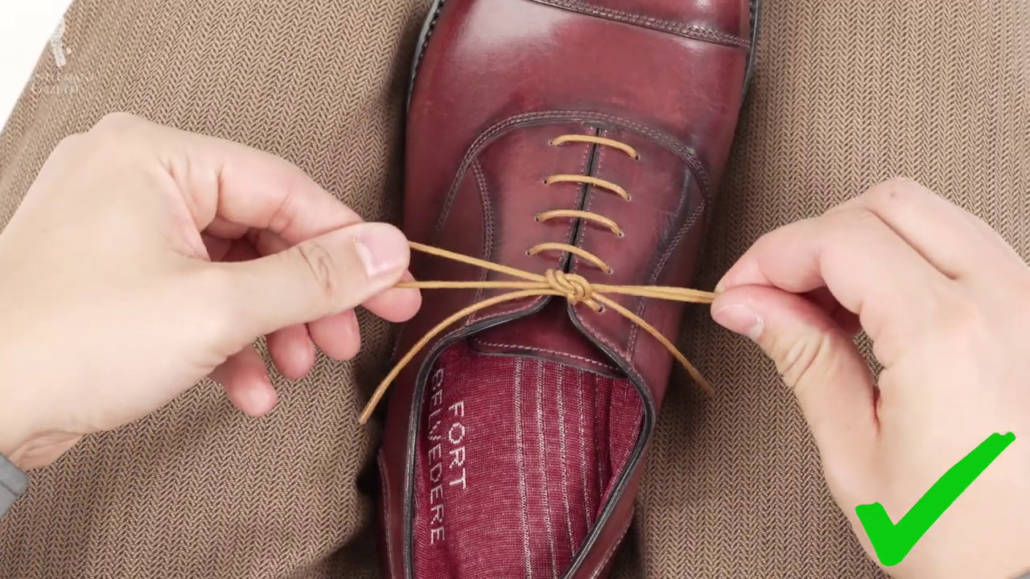
Fortunately, our guide on how to tie your shoes explains the steps to get a perfectly straight bow, which involves reversing the loop direction. It’ll be difficult for righties to make this feel natural at first, but it’s a nice finishing touch, even if only you know that you’ve done it. As a bonus, mastering this technique will also mean that your shoes should stay tied longer.
Conclusion – We all have problems
To be honest, all #GentlemansProblems are the result of seeking perfection, the desire to look not only one’s best but to be flawless in dress. This idea is fed by images on social media or the larger internet, which are professionally photographed or curated to present a highly refined look.
They may present products that are just out of the box with no wear on them, shot under controlled circumstances before having filters applied to them. In reality, such perfection is nearly impossible to maintain.
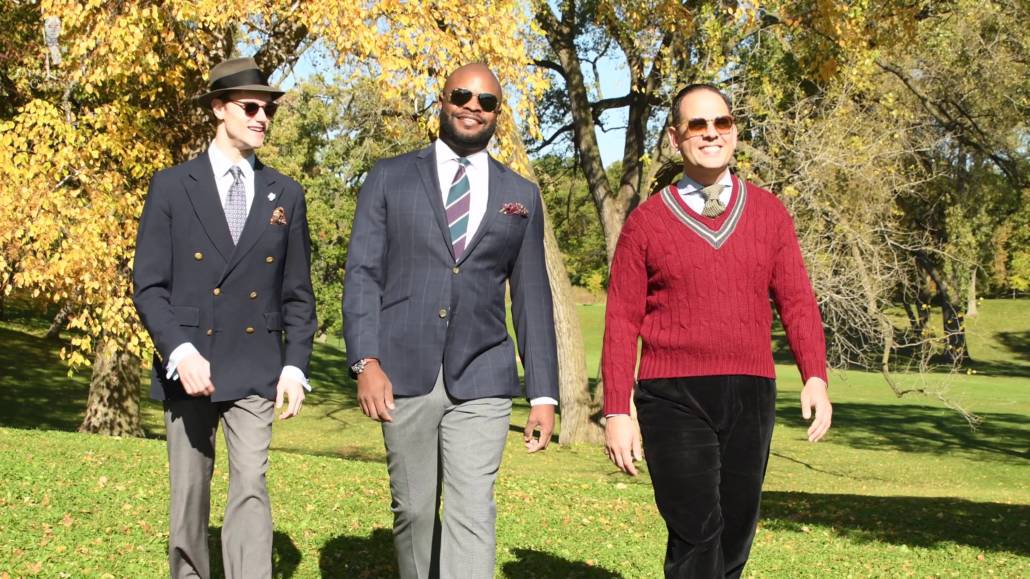
Still, many of us feel we need to look Instagram-ready even “in the wild,” which risks removing all the fun in dressing up. Therefore, especially since most of the people around us will not notice, we should lighten up on issues of dress that only we can see. We can be committed to looking good without agonizing over fastidious concerns.
Outfit Rundown
I’m wearing a number of garments and accessories that serve to illustrate some of the various problems we discussed in this post.
Most readily apparent, of course, would be my dark brown vintage suit jacket featuring a thin pinstripe in tan and light blue, which, as I said, dates to the 1980s and thus has power shoulders that are frankly a bit big for my build, resulting in some shoulder divots.
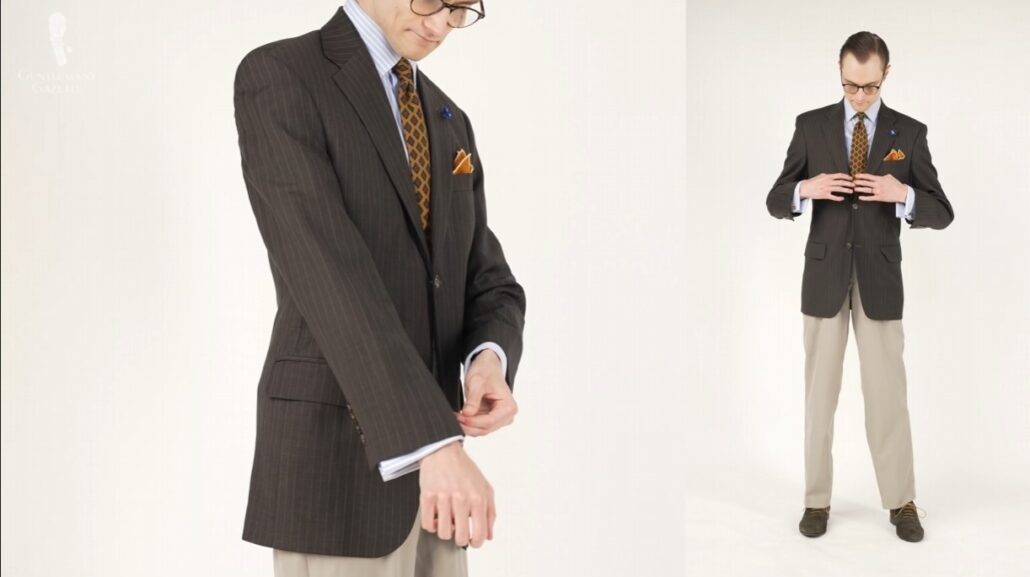
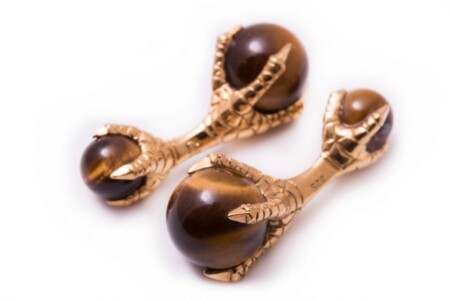
Fort Belvedere
Eagle Claw Cufflinks with Tiger's Eye Balls – 925 Sterling Silver Gold Plated – Fort Belvedere
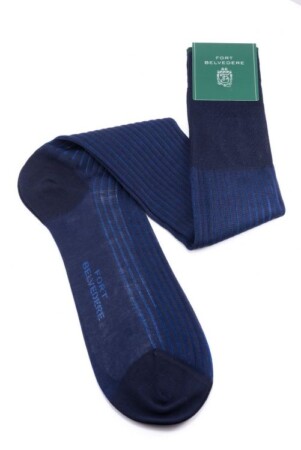
Fort Belvedere
Shadow Stripe Ribbed Socks Dark Navy Blue and Royal Blue Fil d'Ecosse Cotton – Fort Belvedere
Also, the sleeves of the jacket are just a bit short and I haven’t had them let out yet by a tailor. So, they sometimes don’t harmonize perfectly with my shirt sleeves. However, given that the French cuffs of my Charles Tyrwhitt shirt in a striped pattern of light blue and white can be set at two different levels, I’ve got the cuffs oriented slightly shorter today to compensate for the short jacket sleeves.
Into those French cuffs, I’ve got inserted our gold-plated sterling silver eagle claw cufflinks from Fort Belvedere featuring tiger’s eye as the stone, which has some brown and yellow tones to harmonize with many of my other garments. Also from Fort Belvedere today are my two-tone shadow striped socks in navy blue and royal blue, my pocket square, which is in a color we’re calling antique gold ochre and in a wool silk blend featuring printed geometric medallions in beige, red, and blue with a cream contrast edge, and my boutonniere, which is a relatively new design to our shop. It’s a dark blue mini delphinium.
My vintage wool challis tie, which is in a similar gold ochre color, features a repeated geometric motif in green and pink. My trousers are in a stone or khaki color to ground the outfit. And my shoes from Undandy are in dark chocolate brown suede. They’re Oxfords with a cap toe and into them, I’ve got inserted some Fort Belvedere laces in a brighter gold color, which serve to make the shoes pop a bit more and also harmonize with this outfit.
To prevent my trousers from sagging over the course of the day, I’ve also opted to wear suspenders, which are in a blue color, which could harmonize with the outfit. Although, of course, they won’t be seen under the jacket. Additionally, my tie is tucked into the waistband of my trousers given that they do sit relatively high on my waist and the tie would otherwise be too long. And, of course, you can find all of the Fort Belvedere accessories I’m wearing today in the Fort Belvedere shop.
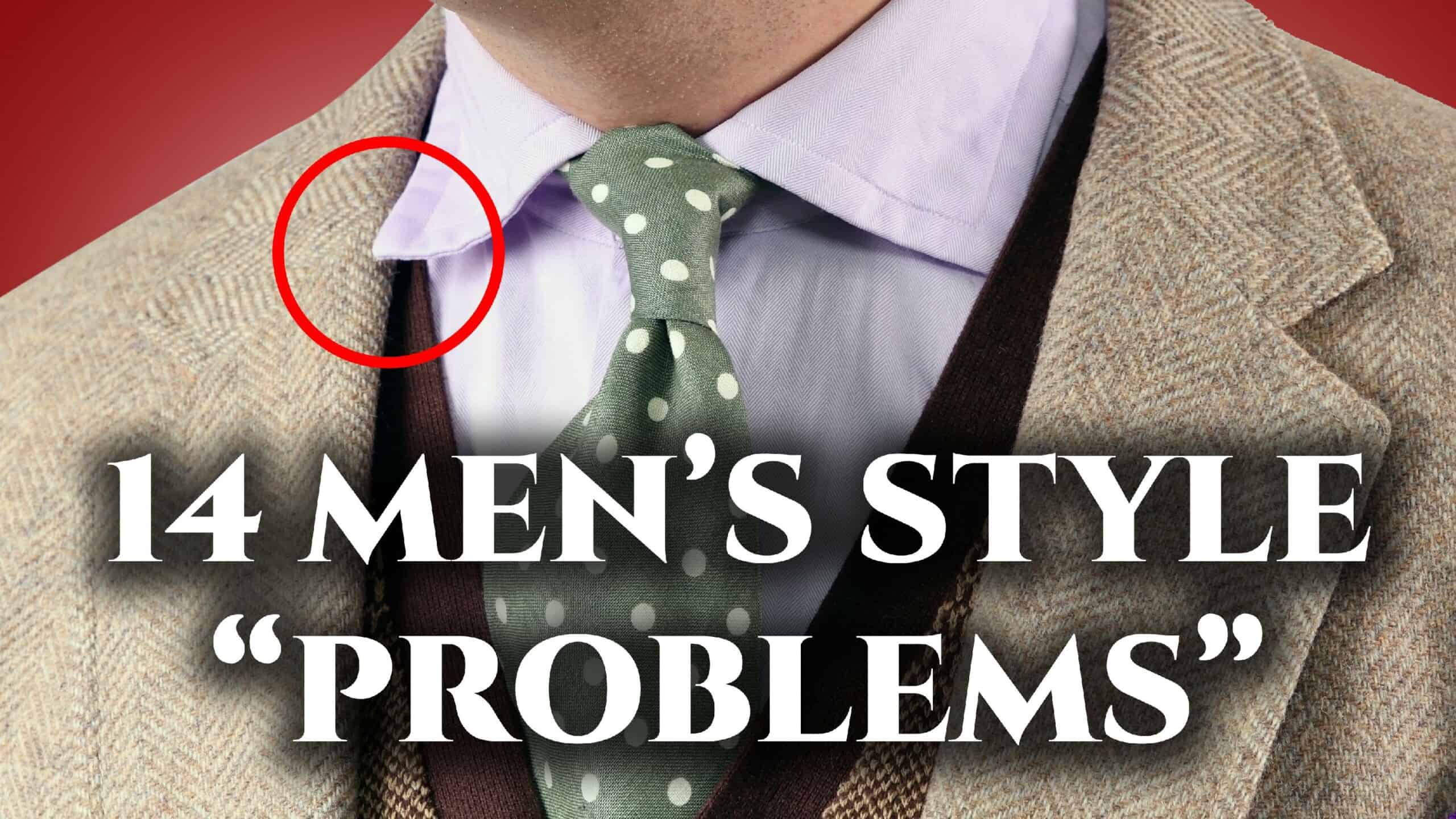

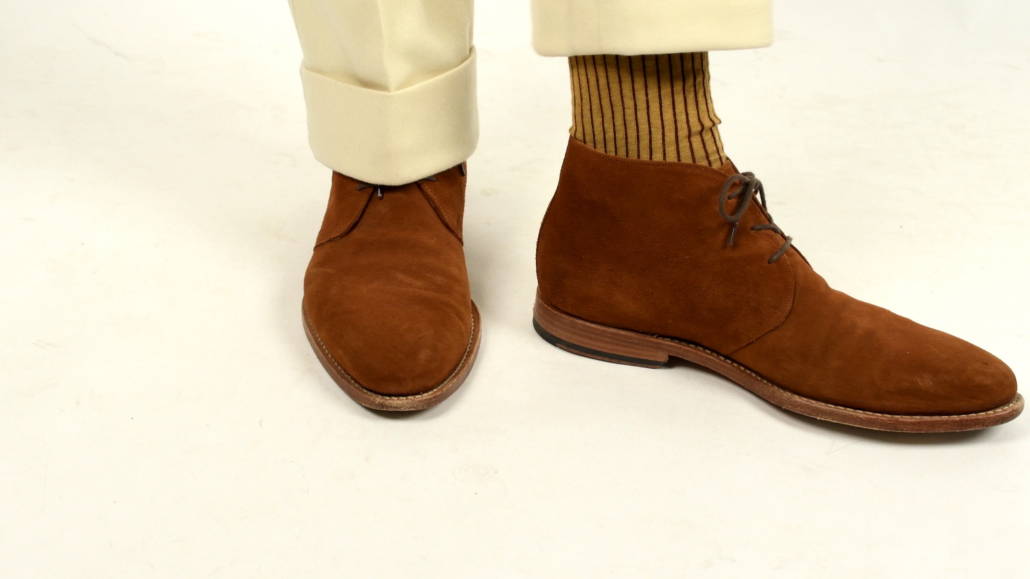
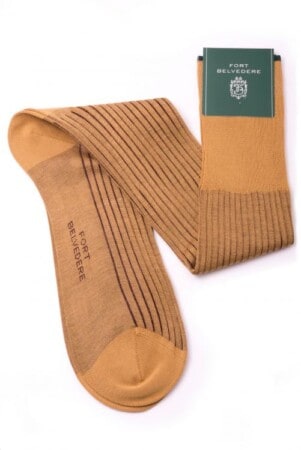
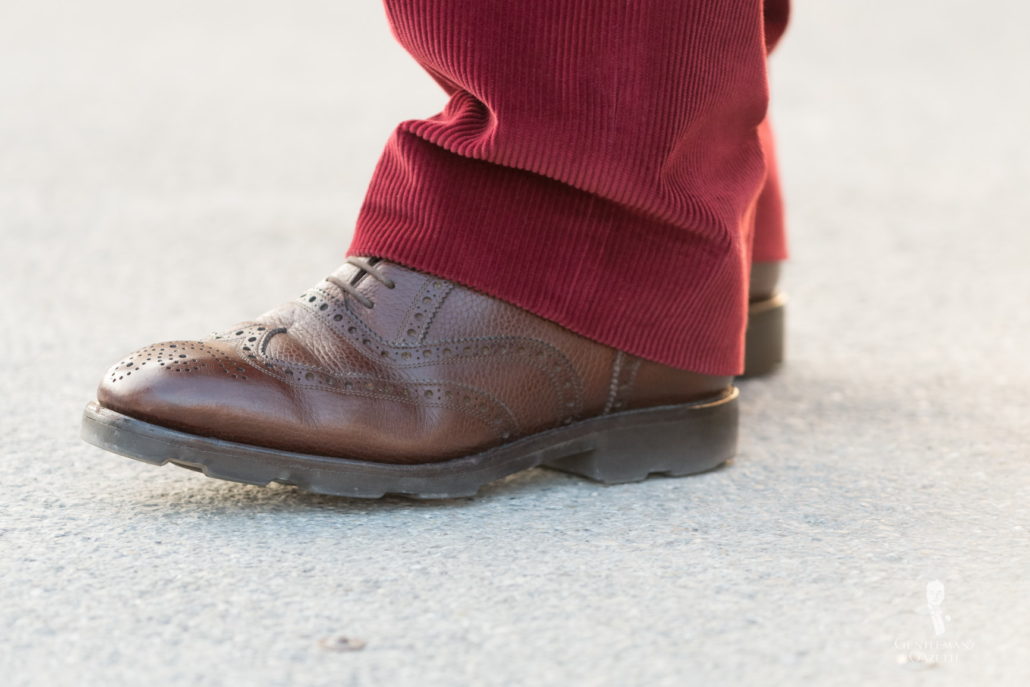
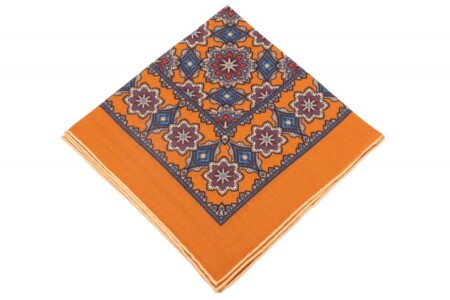
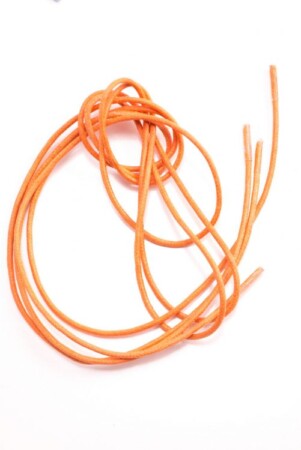
Thank you Dr. Lee! I think we should get to know the classic rules, understand the common mistakes, appreciate when others do this too and then start to ignore the rules whenever they stand in our way and are in fact hindering us of feeling free from superficial thoughts – let’s learn to accept our own imperfections and still thrive to become better gentlemen.
Lino
Thank you Dr Lee for this eloquent essay on the subject of our quest for gentlemanliness. The words “…should lighten up…” are key to besting each and all of the 14 aforementioned issues facing well-dressed gentlemen after paying due technical diligence to the details. I am of the view that “lightening up” helps a gentleman wear his clothes rather than his clothes wearing him.
Great article as usual Dr. However, perhaps sock garters are a little “utterly too too” and after all there are socks that don’t have this problem. Worse, and fortunately few are foolish enough to wear them, are the garters that connect the shirt to the socks or some such thing to keep the shirt tucked in. There are limits to sartorial silliness–one hopes.
I have to disagree about shirt stays. They’re designed to keep crisp clean lines and avoid having to constantly re-tuck one’s shirt due to the dreaded muffin top that occurs when it becomes untucked. You can buy ones that don’t attach to the socks (they have a simple loop around the knee and are designed for the sockless look) although I find holding the socks up is an added bonus.
Oh gosh I found myself laughing at this article. Every single one of these issues drives me utterly bonkers. I’ve always had a slight problem with shoulder divots no matter the cut of the suit, even with bespoke, I figure it’s just the slope of my shoulders.
As for the collar gap, I remember watching Gatsby for the second time about three years after the first time, and Leo’s collar gap drove me to distraction, I couldn’t unsee it, that made me laugh. I wish I could go back to living in ignorance!
As for the sinking pocket square…don’t even go there!
The main reason I have my shirts custom made is so that I can have a high second button on them, between 5 and 5.5 centimetres.
The best solution for ties that are too long is to have them shortened. Any good tailor can shorten a tie. All high end stores will do it. All of my ties have been shortened by various lengths. Any other solution does not work as well. The standard price in the Chicago area seems to be $20. Well worth it.
Tod, I agree. I’ve had it done too–got some ties shortened at the narrow end. The tailor complained about how hard it was to do for some reason, but it was not expensive and turned out well, just as you say.
#15 – Wearing trousers with braces and not removing the belt loops.
Braces aren’t supposed to be visible, though. Conceal with jacket +/- waistcoat and belt loops also concealed. Problem solved.
Gene Rogers,
Hear! Hear!
2 inches between the top shirt button and the next is enough for a gentleman.
A way to at least delay the shoe crease is to alternate shoes on a daily basis. ( ie don’t wear the same shoe two days in a row whenever possible. ) Tend to the shoes as soon as you get home by changing out of them and placing in their shoe trees. This allows the shoe to dry between uses.
I have to smile whenever this issue of slipping shoelaces comes up, and reversing the overhands. Any second-class boy scout can tell you a square knot will hold where a granny will slip. It is the very same concept.
First World Problems indeed!!
Throwing in my two Cents: I think a true Gentleman should not take himself too serious, folks! That is what makes him a gentleman.
A simple solution for retreating pocket squares (most oft silken as the article makes mention) would be to place an invisible supporting pocket square in the bottom of the pocket prior to placing the visible pocket square.
As a guy who wears suits etc for work every day this article intrigued me. I tend to wear my trousers just so they reach the top of the shoe so there is really no break – I prefer the way it looks. Thanks to Gentleman Engineer for the pocket square solution ( I wear them every day). All my shirts have collar stays so collars are not an issue for me.
Thanks for another excellent article.
Yep, First World Problems. And only a problem for OCD accountants. We’re not dealing with White Tie here, folks. Solution for sleeve length problems: Wear a shirt with a sleeve length you like when you get your jacket sleeves done, get the exposure you want, and then forget all about it. Some sleeves will be shorter, some will be longer. Not the end of the world.
Same goes with pants length (and the suspender option is a fantastic recommendation). As far as someone else’s beef with suspenders and belt loops goes, that’s what waistcoats were invented for. If not wearing a waistcoat or double-breasted jacket, you can wear a belt. Suspenders aren’t mean to be seen anyway. If they’re covered up, so are the belt loops. Problem solved. I like having my cake and eating it, too.
And I do like the solution for disappearing pocket squares, but I have no problem with the occasional adjustment of a square. It’s kinda like automatically tugging up your trouser legs when you sit down.
Even with these minor quibbles, we’re still far better-dressed than the VAST majority of guys out there, so we can live with a little nonchalance from time to time.
Are you spying on me? This has been my 40+ years! All of the above (and more!)
With respect, now that we are in the 21st century, how do we carry our mobile phones (ubiquitous these days) without spoiling the effect of a well fitted suit. The trend to move towards larger screen sizes has accentuated the problem. Perhaps there is a place for a compact phone designed to be inconspicuous. Hint – a good topic for a review, Sven.
The only possible solution I’d have to offer about that (provided you get your jackets custom made) would be to have the inner pocket on the right breast enlarged a wee bit to fit a larger phone or get the fit tailored to adjust for putting it in the outer pockets. I’m sure it would still ruin the clean lines unless you had a fair bit of drape to the cut and a reasonably heavy fabric/canvas, but unless Big Electronics realizes people don’t need BIGGER, we’re probably screwed until the stuff starts getting implanted in us.
Do you use an every day carry like a brief case or satchel? The latter often have outside pockets like my sister’s handbag. I often use the outside pockets of my leather satchel and only have a slim bifold wallet in my pockets when I wear a suit.
Good point about larger phones, David. Personally, I believe the decision is where one’s priorities lie – for example, I prefer a smaller, slimmer phone because it means my wardrobe isn’t impacted as much as it would be for a larger phone. If my priorities were to have a larger phone with the latest technology, etc., then I’d perhaps look at making sure my suit and sport jackets are fitted to a point where the phone isn’t conspicuous. I’m currently using a Samsung A40 which is a nice, slim phone on the smaller end of things. I find that not having it in a case helps it not show in a jacket as well, but it does mean I take a little more care when out and about!
When I see jacket collar gape or wrinkles (when the fabric below the collar gets compressed), or sleeve dimples or length issues, I assume that the person doesn’t have a tailor. (The alterations people at a department store don’t really count here.) I don’t judge, and don’t consider it a problem at all – I’m happy the person is putting in the effort! A tailor costs money, and sometimes the jacket is a stretch financially. Don’t sweat it! But a good tailor can fix or mitigate a lot of jacket issues.
Shoe trees and not wearing a specific pair of dress shoes to death really does work. I’ve gotten a lot of shoe trees at Nordstrom Rack for under $20 a pair. It’s cheap insurance. Rotation is key. If you can afford shell cordovan, wrinkles don’t happen as much, but you still can’t wear them every day. I try not to wear a particular pair of dress shoes more than once or twice a week.
I was pleasantly surprised when this article turned out to be about actual (although definitely niggling and “first world”) problems that I see in the mirror, and even containing suggestions and explanations. I was thinking I might read things like “Excessive compliments from one and all” or similar joke-y non-problems. Well done!
Thank you! We’re certainly glad to hear you enjoyed it :)
Add #15 people who think button down shirt = dress shirt. I’ve seen this in a few TV shows and movies since discovering GG and RMRS and as much a First World problem as it is, it antagonises me seeing men in suits and ties substituting dress shirts with button down collars. Case in point: The Intern.
https://www.youtube.com/watch?v=x7bmt7_svd4
Seeing Ben’s character in this combo particularly bothers me as he’s a bit of a clothes horse like Raphael and similarly, often dresses in suits and ties. You’d think the wardrobe people would realise this and dress Robert DeNiro more accordingly.
The situation has a lot to do with the way an outfit is put together. In your example of The Intern, I feel that DeNiro’s character Ben is suitably attired for an interview at a young, modern e-commerce company.
His suit is plain grey wool, the tie is burgundy with an elegant white pin-dot and his shirt looks to be a light blue poplin rather than an Oxford cloth button down. As the shirt is made from a more formal fabric, the look is neither too formal to alienate his potential employers, nor too casual to look as though it’s mismatched with the suit.
In this case, it’s all about understanding the different scales of formality, which we discuss more in this article.
It’s not the suit or tie or even shirt fabric that are the issues. Rather it’s the button down collar that bugs me. The article about differing scales of formality proves my point beautifully.
I suppose the essence of style is that it’s subjective, which opens the doors for these discussions :)
I’m gonna hafta side with Jack on this one. With certain suits, button-down collars are kosher in my book. I’d never wear one with double-breasted, and certainly not with a fine worsted in solid charcoal or pinstripe, but when I wear seersucker or linen suits in particular, I think button-down collars work fine. I even wear an OCBD with a 3-piece puppytooth flannel on occasion.
I was pleasantly surprised when this article turned out to be about actual (although definitely niggling and “first world”) problems that I see in the mirror, and even containing suggestions and explanations